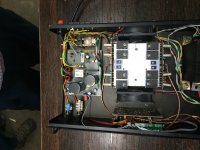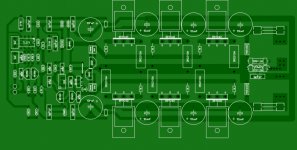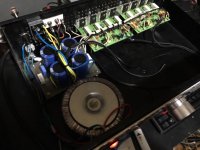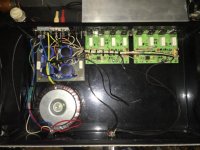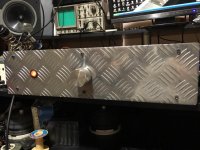?
If Vout rises and takes the diode voltages with it, the other diode still conducts and the LED still glows.
If Vout falls to well below Pgnd, then when Vout + Vf < Vdiode+ Vled then the LED turns off.
So I ask again what does the diode to OUT do? Turn off the LED?
Yes diode turn the LED off.
Ground for input amplifier must be conect with separate wire from PSU.
Sorry I did not read entire thread, so maybe someone mentioned about this.
Is this a common way to connect signal ground? It goes to amp board and PSU board and the chassis ground.
Amplifier with no adjust (offset, bias) +/-60V. Simple to build, no oscilation, hum and noise. Praktik, usuful and good sound.
Also sorry for my novice question: what's the purpose of D13 and D14 diodes that going across output transistors?
so the diode to OUT turns off the LED, when OUT goes >~ 700mV negative?
No, LED is off and turn on when OUT is over +2V
That's not what I see.
The diode between Out and circuit becomes reverse biased when the OUT goes high.
The resistor supplies current to the LED. The LED is ON.
If Out is near GND voltage the diode does nothing, it might be reverse biased, or slightly forward biased. No effect on LED operation.
If OUT is heavily negative, the diode is forward biased and pulls the circuit negative.
Now no current flows through the LED, instead the current flows through the OUT diode.
The Diode turns the LED OFF, when OUT goes -ve.
The diode between Out and circuit becomes reverse biased when the OUT goes high.
The resistor supplies current to the LED. The LED is ON.
If Out is near GND voltage the diode does nothing, it might be reverse biased, or slightly forward biased. No effect on LED operation.
If OUT is heavily negative, the diode is forward biased and pulls the circuit negative.
Now no current flows through the LED, instead the current flows through the OUT diode.
The Diode turns the LED OFF, when OUT goes -ve.
The way I see it is when the "out" is at zero volts the diode feeding the "out" will steal the voltage from the LED. As the voltage on the out goes positive it no longer conducts so the voltage goes through to the LED. Should be easy enough to test.
The way I see it is when the "out" is at zero volts the diode feeding the "out" will steal the voltage from the LED. As the voltage on the out goes positive it no longer conducts so the voltage goes through to the LED. Should be easy enough to test.
Circuit is tested.
Regards
Hello apexaudio
greetings thank you for your FX100 power supply it works great uploading
vedio showing short circuit protection i am working on your D2000 dclass
warm regards
Andrew
greetings thank you for your FX100 power supply it works great uploading
vedio showing short circuit protection i am working on your D2000 dclass
warm regards
Andrew
pardon me, but i was not able to locate the video. it took me to your facebook page.
reg
Prasi
pardon me, but i was not able to locate the video. it took me to your facebook page.
reg
Prasi
https://www.youtube.com/watch?v=tvOE_fdcq8Y
Hello guys .. Almost finished F100 View attachment 538340
View attachment 538341
View attachment 538342
View attachment 538343
Your a man after my own heart with that diamond plate
- Home
- Amplifiers
- Solid State
- DC Servo MOSFET Amplifier
